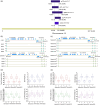Genome-wide quantitative trait loci reveal the genetic basis of cotton fibre quality and yield-related traits in a Gossypium hirsutum recombinant inbred line population
- PMID: 31199554
- PMCID: PMC6920336
- DOI: 10.1111/pbi.13191
Genome-wide quantitative trait loci reveal the genetic basis of cotton fibre quality and yield-related traits in a Gossypium hirsutum recombinant inbred line population
Abstract
Cotton is widely cultivated globally because it provides natural fibre for the textile industry and human use. To identify quantitative trait loci (QTLs)/genes associated with fibre quality and yield, a recombinant inbred line (RIL) population was developed in upland cotton. A consensus map covering the whole genome was constructed with three types of markers (8295 markers, 5197.17 centimorgans (cM)). Six fibre yield and quality traits were evaluated in 17 environments, and 983 QTLs were identified, 198 of which were stable and mainly distributed on chromosomes 4, 6, 7, 13, 21 and 25. Thirty-seven QTL clusters were identified, in which 92.8% of paired traits with significant medium or high positive correlations had the same QTL additive effect directions, and all of the paired traits with significant medium or high negative correlations had opposite additive effect directions. In total, 1297 genes were discovered in the QTL clusters, 414 of which were expressed in two RNA-Seq data sets. Many genes were discovered, 23 of which were promising candidates. Six important QTL clusters that included both fibre quality and yield traits were identified with opposite additive effect directions, and those on chromosome 13 (qClu-chr13-2) could increase fibre quality but reduce yield; this result was validated in a natural population using three markers. These data could provide information about the genetic basis of cotton fibre quality and yield and help cotton breeders to improve fibre quality and yield simultaneously.
Keywords: QTL clusters; consensus genetic map; fibre quality; fibre yield; gene expression level; genetic correlation; upland cotton.
© 2019 The Authors. Plant Biotechnology Journal published by Society for Experimental Biology and The Association of Applied Biologists and John Wiley & Sons Ltd.
Conflict of interest statement
The authors declare no conflicts of interest.
Figures





Similar articles
-
A high-density genetic map and multiple environmental tests reveal novel quantitative trait loci and candidate genes for fibre quality and yield in cotton.Theor Appl Genet. 2020 Dec;133(12):3395-3408. doi: 10.1007/s00122-020-03676-z. Epub 2020 Sep 7. Theor Appl Genet. 2020. PMID: 32894321
-
High-density linkage map construction and QTL analyses for fiber quality, yield and morphological traits using CottonSNP63K array in upland cotton (Gossypium hirsutum L.).BMC Genomics. 2019 Nov 21;20(1):889. doi: 10.1186/s12864-019-6214-z. BMC Genomics. 2019. PMID: 31771502 Free PMC article.
-
Identification of candidate genes for key fibre-related QTLs and derivation of favourable alleles in Gossypium hirsutum recombinant inbred lines with G. barbadense introgressions.Plant Biotechnol J. 2020 Mar;18(3):707-720. doi: 10.1111/pbi.13237. Epub 2019 Sep 20. Plant Biotechnol J. 2020. PMID: 31446669 Free PMC article.
-
Fiber Quality Improvement in Upland Cotton (Gossypium hirsutum L.): Quantitative Trait Loci Mapping and Marker Assisted Selection Application.Front Plant Sci. 2019 Dec 11;10:1585. doi: 10.3389/fpls.2019.01585. eCollection 2019. Front Plant Sci. 2019. PMID: 31921240 Free PMC article. Review.
-
Genome-wide association study reveals novel quantitative trait loci and candidate genes of lint percentage in upland cotton based on the CottonSNP80K array.Theor Appl Genet. 2022 Jul;135(7):2279-2295. doi: 10.1007/s00122-022-04111-1. Epub 2022 May 16. Theor Appl Genet. 2022. PMID: 35570221 Review.
Cited by
-
The transcriptome landscapes of citrus leaf in different developmental stages.Plant Mol Biol. 2021 Jul;106(4-5):349-366. doi: 10.1007/s11103-021-01154-8. Epub 2021 Apr 19. Plant Mol Biol. 2021. PMID: 33871796
-
Identification and analysis of oil candidate genes reveals the molecular basis of cottonseed oil accumulation in Gossypium hirsutum L.Theor Appl Genet. 2022 Feb;135(2):449-460. doi: 10.1007/s00122-021-03975-z. Epub 2021 Oct 29. Theor Appl Genet. 2022. PMID: 34714356
-
Reveal genomic insights into cotton domestication and improvement using gene level functional haplotype-based GWAS.Nat Commun. 2025 May 21;16(1):4734. doi: 10.1038/s41467-025-59983-w. Nat Commun. 2025. PMID: 40399334 Free PMC article.
-
A consensus map for quality traits in durum wheat based on genome-wide association studies and detection of ortho-meta QTL across cereal species.Front Genet. 2022 Aug 30;13:982418. doi: 10.3389/fgene.2022.982418. eCollection 2022. Front Genet. 2022. PMID: 36110219 Free PMC article.
-
Aspartyl proteases identified as candidate genes of a fiber length QTL, qFLD05, that regulates fiber length in cotton (Gossypium hirsutum L.).Theor Appl Genet. 2024 Feb 26;137(3):59. doi: 10.1007/s00122-024-04559-3. Theor Appl Genet. 2024. PMID: 38407588
References
-
- Cai, H.W. and Morishima, H. (2002) QTL clusters reflect character associations in wild and cultivated rice. Theor. Appl. Genet. 104, 1217–1228. - PubMed
-
- Cai, C.P. , Niu, E.L. , Du, H. , Zhao, L. , Feng, Y. and Guo, W.Z. (2014) Genome‐wide analysis of the WRKY transcription factor gene family in Gossypium raimondii and the expression of orthologs in cultivated tetraploid cotton. Crop J. 2, 87–101.
-
- Cao, Z.B. , Zhu, X.F. , Chen, H. and Zhang, T.Z. (2015) Fine mapping of clustered quantitative trait loci for fiber quality on chromosome 7 using a Gossypium barbadense introgressed line. Mol. Breed. 35, 1–13.
-
- Chandnani, R. , Kim, C. , Guo, H. , Shehzad, T. , Wallace, J.G. , He, D.H. , Zhang, Z.S. et al. (2018) Genetic analysis of gossypium fiber quality traits in reciprocal advanced backcross populations. Plant Genome. 11, 170057. - PubMed
Publication types
MeSH terms
Substances
LinkOut - more resources
Full Text Sources

